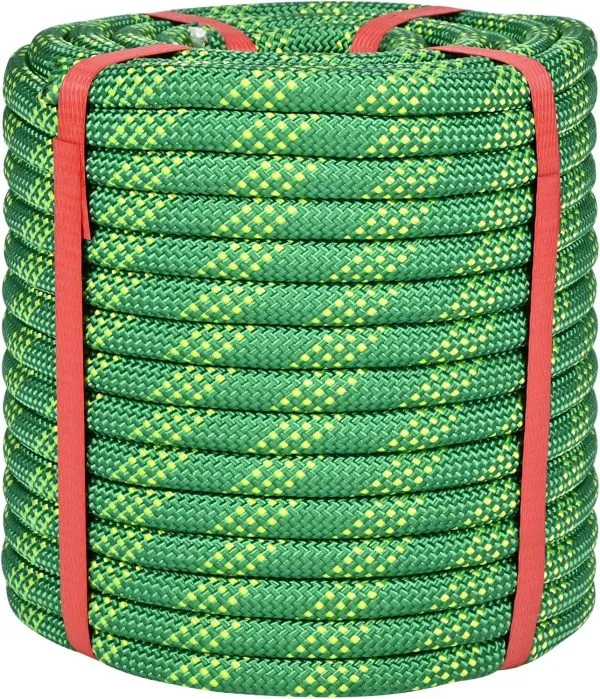Cointeaching Outdoor product specialty store, safeguarding your safety.

The Ultimate Guide to Choosing the Right Climbing Rope
When it comes to climbing, whether for tree work, rappelling, or recreational activities, having the right rope is crucial for safety and performance. A high-quality climbing rope can make all the difference in your experience, ensuring you have the strength and reliability needed for your adventure. In this guide, we’ll explore the benefits of using a static climbing rope, key features to look for, and tips for safe usage.
The Benefits of Using a Static Climbing Rope
- High Strength and Durability
Static climbing ropes, such as a 1/2 inch rope with 48 strands, are designed for heavy-duty use. They provide significant strength and durability, making them ideal for various applications including tree climbing, rappelling, and rigging. Their robust construction ensures they can withstand the stresses of climbing and heavy loads without compromising safety. - Minimal Stretch
One of the primary advantages of static ropes is their minimal stretch. Unlike dynamic ropes, which are designed to absorb the shock of a fall, static ropes maintain their length under load. This characteristic is particularly beneficial for activities like tree climbing and rigging, where precise control is essential. The lack of stretch allows for better positioning and stability during climbs. - Versatility for Multiple Applications
A static climbing rope is versatile enough for various applications beyond climbing. It can be used for tree pulling, constructing swings, nautical rigging, and other outdoor activities. This versatility makes it a valuable addition to your gear collection, ensuring you have a dependable rope for different needs.
Key Features to Look For
- Material Composition
Climbing ropes are typically made from nylon or polyester, or a combination of both. Nylon offers excellent strength and elasticity, while polyester is known for its durability and resistance to UV damage. A rope made from a blend of these materials can provide the best of both worlds—strength, durability, and minimal stretch. - Diameter and Weight
The diameter of the rope is crucial for determining its strength and handling characteristics. A 1/2 inch diameter offers a good balance between strength and weight, making it easy to handle while providing ample support. Consider the weight of the rope as well, especially if you plan to carry it on long climbs. - Braided Construction
A braided rope design enhances strength and flexibility. Look for ropes with a tightly woven braid that resists abrasion and wear, ensuring longevity even in challenging conditions. The construction should also provide good grip for handling, especially when tying knots or securing loads. - Length
The length of the rope you choose will depend on your specific needs. A 100-foot length is versatile for various applications, allowing for enough reach for tree climbing, rappelling, or setting up swings. Always ensure you have enough rope for your intended use, factoring in any additional length needed for knots.
Tips for Safe Usage
- Inspect Your Rope Regularly
Before each use, inspect your climbing rope for any signs of wear, fraying, or damage. Look for cuts, abrasions, or unusual textures. If you notice any significant wear, it’s advisable to retire the rope to ensure your safety. - Practice Proper Knot Techniques
Ensure you are familiar with essential climbing knots, such as the figure-eight knot, bowline, and double fisherman’s knot. Proper knot tying is crucial for securing your rope and ensuring safety during climbs. Always double-check your knots before use. - Store Your Rope Properly
After use, clean your rope if it has been exposed to dirt, moisture, or saltwater. Store it in a cool, dry place, away from direct sunlight and sharp objects. Use a rope bag or container to prevent tangling and abrasion. - Follow Safety Guidelines
Always adhere to safety guidelines and best practices when using climbing ropes. Wear appropriate safety gear, such as a harness and helmet, and ensure you have a partner or spotter when engaging in climbing activities. Familiarize yourself with the environment and any potential hazards.
Conclusion
Choosing the right climbing rope is essential for safety and performance in various climbing and outdoor activities. A static rope, such as a 1/2 inch, 100-foot option, offers strength, durability, and versatility for tree climbing, rappelling, and more. By understanding key features to look for and following safety practices, you can ensure a secure and enjoyable climbing experience. Equip yourself with the right tools and embrace the adventure ahead with confidence!
